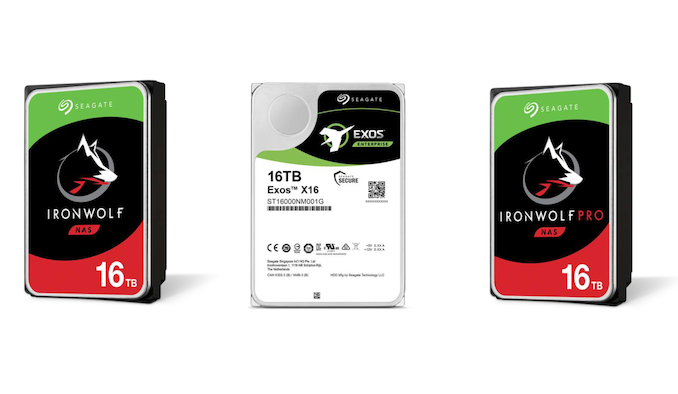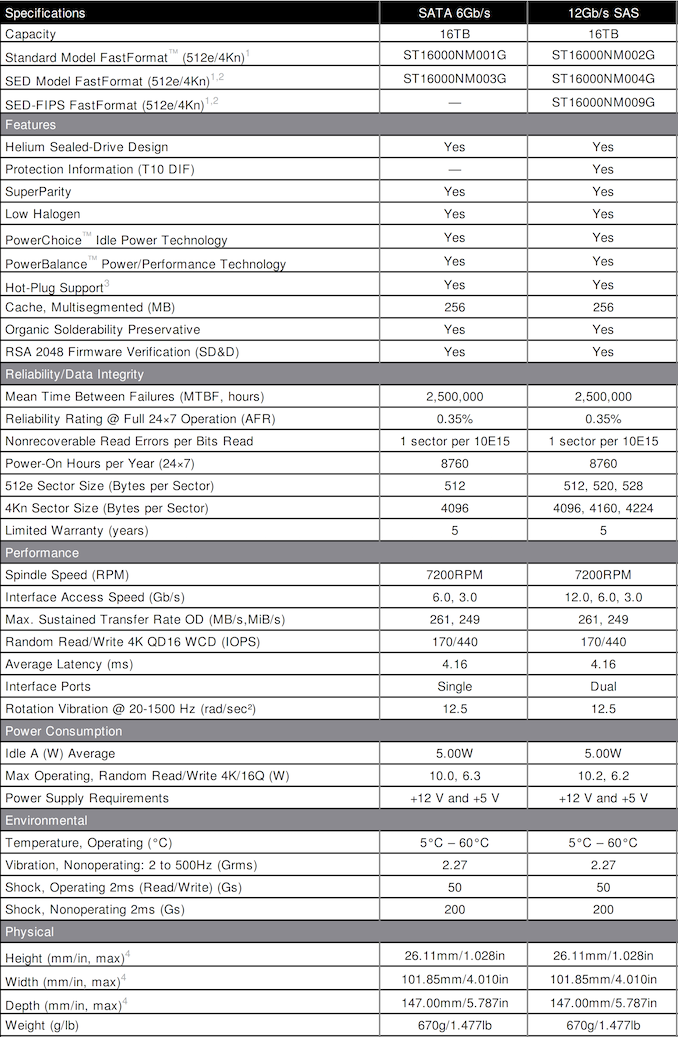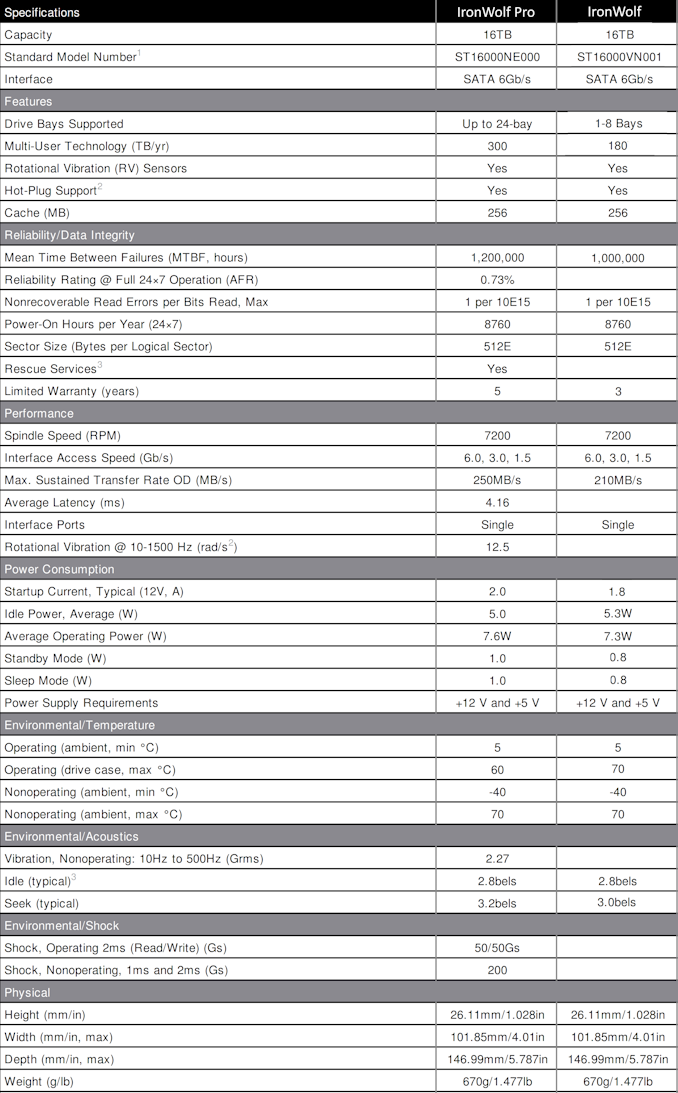Seagate Announces Helium-based 16 TB Exos and IronWolf Hard Drives
by Ganesh T S on June 4, 2019 8:01 AM EST- Posted in
- Storage
- Seagate
- HDDs
- Helium HDD
- IronWolf
- Exos
- IronWolf Pro

Seagate is launching their 16 TB CMR (conventional magnetic recording) helium drives today under two product lines - the Exos X for datacenter usage, and the IronWolf / IronWolf Pro for NAS units. The company has been actively shipping the Exos X drives to hyperscale customers, and today's launch is geared more towards the retail market. Similar to the currently available 14TB drives from Seagate, the new 16TB variants also use TDMR (two-dimensional magnetic recording) technology for the heads
The Exos X16 is a 3.5" 7200 RPM drive with SED (self-encrypting drive) options. It is currently the leading capacity point available across all HDD vendors, but, not the first 16 TB drive publicly announced - that credit goes to Toshiba's MG08 series launched in January 2019. Similar to Toshiba's MG08 series, the Seagate 16TB drives also use nine platters to achieve the capacity point.
Seagate claims that the new Exos X16 delivers 33% additional storage per rack compared to the 12 TB variants - thereby reducing the TCO for datacenter operators. The Exos X series is available in both SATA 6Gbps and SAS 12Gbps versions.
The 16 TB drives are also being made available under the IronWolf and IronWolf Pro branding - these drives carry a 300TB/yr workload rating, and deliver benefits typically required in SOHO / SMB NAS systems.
The Exos X16 16TB HDD SATA model (ST16000NM001G) has an MSRP of $629 and is available for purchase today. The dual-port SAS model (ST16000NM002G) is priced at $639. The detailed specifications of the various Exos X16 variants are reproduced in the table below.
The IronWolf Pro (ST16000NE000) has a MSRP of $665 and the IronWolf (ST16000VN001) is priced at $610. These models come with the Rescue Data Recovery Service. The detailed specifications are presented in the table below. The IronWolf 16TB drive is rated for 600K load/unload cycles. The corresponding figure for Exos X16 and the IronWolf Pro were not provided.
Seagate might not be the first to publicly announce a 16TB HDD. However, there is no sign of the previously announced Toshiba MG08 series in the retail market. Seagate's 16TB drives are available for purchase today.












36 Comments
View All Comments
ballsystemlord - Wednesday, June 5, 2019 - link
Aw shucks (he he he).Sorry.
ballsystemlord - Wednesday, June 5, 2019 - link
Thanks for the tips guys. I'll continue to watch this thread.shadowx360 - Tuesday, June 4, 2019 - link
I wouldn’t trust Seagate with 1TB of my data, let alone 16TB. You know what else reduces TCO? Fewer catastrophic drive failures. Seagate is by far the worse of the hard drive OEMs for reliability both from experience and Backblaze data.r3loaded - Tuesday, June 4, 2019 - link
Check the Backblaze data again, Seagate is coming out tops alongside Hitachi. It's WD you want to be wary of.Beaver M. - Wednesday, June 5, 2019 - link
At least on high capacity drives. Low capacity drives still seem the be trash from Seagate.Toshiba is also very good. I guess since they use Hitachi tech.
iamafishiswear - Tuesday, June 4, 2019 - link
Why do people keep regurgitating those Backblaze stats from years ago? You do realise they update and release those quite often don't you? Every quarter to be exact.Yes, the 4TB Seagates were a mess, but that was quite a few years ago already.
Like r3loaded says, check the data again, here's there latest for 2019 Q1: https://www.backblaze.com/blog/backblaze-hard-driv...
This shows that something is up with both Seagate's and HGST's 12TB lines, higher failure rates than normal in Q1.
Looking at their lifetime stats, you can see that the WD60EFRX had an even worse trackrecord than the ST4000DM000 from Seagate. Results made in the past don't garantuee future prospects, so don't regurgitate old statistics that don't hold water in new product-lines.
Beaver M. - Wednesday, June 5, 2019 - link
Look closely.Seagates failure rate on those 12 TB is more or less as it was before. The HGST one is just that. One drive. That could just be a rare exception. You will have to wait until you can say that theres something wrong with them. But safe to say, those drive have already existed for a long time, so you would see more fail if there really was a problem.
DanNeely - Wednesday, June 5, 2019 - link
The HGST 12 TB drives are too new to say much; but if you scroll down to the lifetime stats the Seagate 12 TB drives have an average age of ~10 months; and a 1.65% annual failure rate; which is noticably higher than the ~1% that their 6-10TB models have shown. Backblaze themselves have noted that Seagate's numbers have been trending the wrong way for the last 9 months. The 12's aren't bad drives by any means; but the uptick there is noticeable enough that if I was going to build a raid today with Seagate drives I'd lean toward the precautionary route of going with 8 or 10s instead of 12s and not just because the marginal price/TB ticks up a fair amount for the larger size.BikeDude - Sunday, July 7, 2019 - link
Some IronWolf drives struggle with write cache issues. See https://community.synology.com/enu/forum/6/post/12... and similar threads in that forum.evilspoons - Tuesday, June 4, 2019 - link
Yeesh, I remember the transition from the 6.4 GB drive to 8 and 10 GB and they didn't cost much less than this when accounting for inflation. (Or 20 MB to 40 MB...)I wouldn't mind some sort of NAS setup with a you these new 10-16 TB drives to keep my digital packrat inside satisfied.